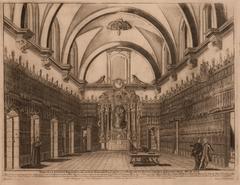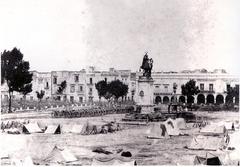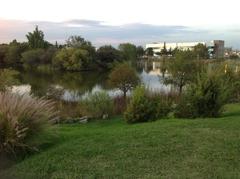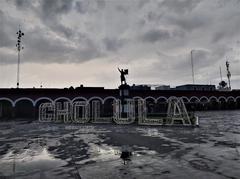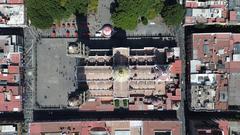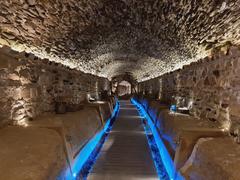Iglesia De Nuestra Señora De La Luz Puebla City Mexico: Visiting Hours, Tickets, and Travel Guide
Date: 14/06/2025
Introduction
The Iglesia de Nuestra Señora de la Luz is a distinguished landmark located in the vibrant heart of Puebla City. This remarkable church not only exemplifies the city’s rich colonial and artistic heritage but also serves as a dynamic center for spiritual devotion and community life. With its unique blend of Baroque exuberance and Neoclassical restraint, decorated with Puebla’s iconic Talavera tiles, the church stands as a testament to both European influence and indigenous tradition. Whether you are an architecture enthusiast, a pilgrim, or a cultural traveler, the Iglesia de Nuestra Señora de la Luz offers an insightful journey into the layered history and living traditions of Puebla (CVC Cervantes; Programa Destinos México; iglesiasymisas.com.mx).
Table of Contents
- Historical Context & Origins
- Architectural Features
- Artistic and Symbolic Elements
- Cultural Significance and Community Role
- Visiting Information: Hours, Tickets, Accessibility
- Practical Tips and Nearby Attractions
- Frequently Asked Questions (FAQ)
- Conclusion and Recommendations
- References
Historical Context & Origins
Foundation and Development
Constructed between 1767 and 1805 under the patronage of Don Manuel del Toro, the Iglesia de Nuestra Señora de la Luz reflects the transition from the ornate Baroque to the more restrained Neoclassical style. Don Manuel del Toro, a Spanish patron who lived among Puebla’s indigenous communities, fostered a spirit of cultural synthesis, commissioning local artisans and integrating indigenous traditions into the church’s design. Significantly, the church was built atop the Cerro de la Estrella, a site of indigenous spiritual importance, further cementing its role as a bridge between pre-Hispanic and Catholic religious practices (CVC Cervantes).
Syncretic Origins
The church’s dedication to Nuestra Señora de la Luz (Our Lady of Light) resonates deeply with local traditions, echoing the indigenous veneration of Tonantzin. This syncretism is still evident in the church’s liturgies and community celebrations, blending Catholic rites with indigenous customs, music, and dance (iglesiasymisas.com.mx).
Architectural Features
Exterior Design
The façade of the church is characterized by a harmonious blend of gray cantera stone, vibrant red brick, and colorful Talavera tiles arranged in geometric and floral patterns. Twin bell towers with diminishing registers and cupolas provide symmetry and verticality, while the dome—adorned with sunburst-patterned tiles and capped by a lantern—crowns the structure with elegance (Programa Destinos México; Bluffton University).
Interior Layout
The church’s Greek cross floor plan is unique within Puebla, balancing nave and transept in equal proportions. The interior features late Baroque and early Neoclassical altars, colonial-era paintings by Miguel de Mendoza, and a modest yet serene atmosphere illuminated by natural light filtering through stained glass windows (Programa Destinos México).
Talavera Tilework
Talavera tiles—hand-painted and rooted in both Spanish and indigenous techniques—adorn the lower walls and chapels, connecting the church to Puebla’s artisanal heritage (Voyage Mexique).
Artistic and Symbolic Elements
Iconography & Decorative Program
Scholars note the church’s iconographic parallels to Mexico City’s Sagrario Metropolitano: the façade serves as a canvas for sculpted saints, prophets, and Marian symbols, while polychrome panels depict the Virgin of Light, Saint Joseph, and Joachim and Anne. Smaller panels at the entrance illustrate Marian attributes—such as the palm, cedar, and well—each symbolizing aspects of the Virgin’s purity and intercessory power (CVC Cervantes; Bluffton University).
Interior Artworks
The church houses notable paintings by Miguel de Mendoza, including scenes from the lives of Saint John Nepomucene and the Virgin Mary. The main altar showcases gilded carvings and a central image of Nuestra Señora de la Luz, surrounded by angels and religious motifs.
Cultural Significance and Community Role
The Iglesia de Nuestra Señora de la Luz is deeply embedded in the social and spiritual fabric of Puebla. It remains a focal point for Marian devotion, hosting vibrant annual processions, feast days in May, and community events that blend religious solemnity with local color (El Sol de Puebla). The church is also a center for cultural activities such as concerts and poetry readings, reinforcing its status as a living monument.
Visiting Information: Hours, Tickets, Accessibility
- Location: Avenida 2 Oriente and 14 Sur, Barrio de la Luz, Puebla City (Identidad Puebla).
- Visiting Hours: Generally open from 9:00 AM to 6:00 PM daily. Hours may vary during religious services and special events (Paseo por México).
- Entry Fee: Free of charge; donations are appreciated.
- Accessibility: Wheelchair accessible via ramps at the main entrance; however, some areas may have uneven flooring due to the historic structure.
- Photography: Allowed, but please refrain from using flash during services or photographing worshippers without consent.
- Guided Tours: Available through local agencies and city walking tours (Voyage Mexique).
Practical Tips and Nearby Attractions
- Best Time to Visit: Early mornings or late afternoons provide optimal lighting for photography and quieter visits.
- Dress Code: Modest attire is recommended; hats should be removed inside.
- Transport: Easily accessible by public transit, taxi, or on foot from the historic center.
- Nearby Attractions: Explore nearby sites such as Puebla Cathedral, Capilla del Rosario, Museo Amparo, Barrio de Analco, and Mercado de Artesanías El Parián (Discover Puebla).
- Facilities: Restrooms are typically not available inside; nearby cafés and restaurants offer amenities.
Frequently Asked Questions (FAQ)
Q: What are the visiting hours?
A: The church is generally open from 9:00 AM to 6:00 PM daily.
Q: Is there an entrance fee?
A: No, but donations are welcomed.
Q: Are guided tours available?
A: Yes, through local tourism services and walking tour operators.
Q: Is the church accessible for people with disabilities?
A: Wheelchair ramps are available at the entrance, but some uneven surfaces may be present.
Q: Can I take photos inside?
A: Yes, but please avoid flash and be respectful during services.
Q: What is the best time to visit?
A: Early morning or late afternoon for the best ambiance and fewer crowds.
Conclusion and Recommendations
The Iglesia de Nuestra Señora de la Luz stands as a vibrant symbol of Puebla’s layered history and cultural richness. Its architectural splendor, artistic treasures, and ongoing traditions of Marian devotion make it an essential stop for anyone seeking to understand the city’s unique blend of colonial and indigenous heritage. Plan your visit to coincide with local festivals for a more immersive experience, and consider joining a guided tour for deeper context.
For further information, digital guides, and updates on community events, download the Audiala app and explore official Puebla tourism resources. Stay connected on social media for the latest travel tips and cultural news.
References
- CVC Cervantes
- Programa Destinos México
- iglesiasymisas.com.mx
- horariodemisas.com.mx
- Voyage Mexique
- Identidad Puebla
- Paseo por México
- El Sol de Puebla
- Discover Puebla


